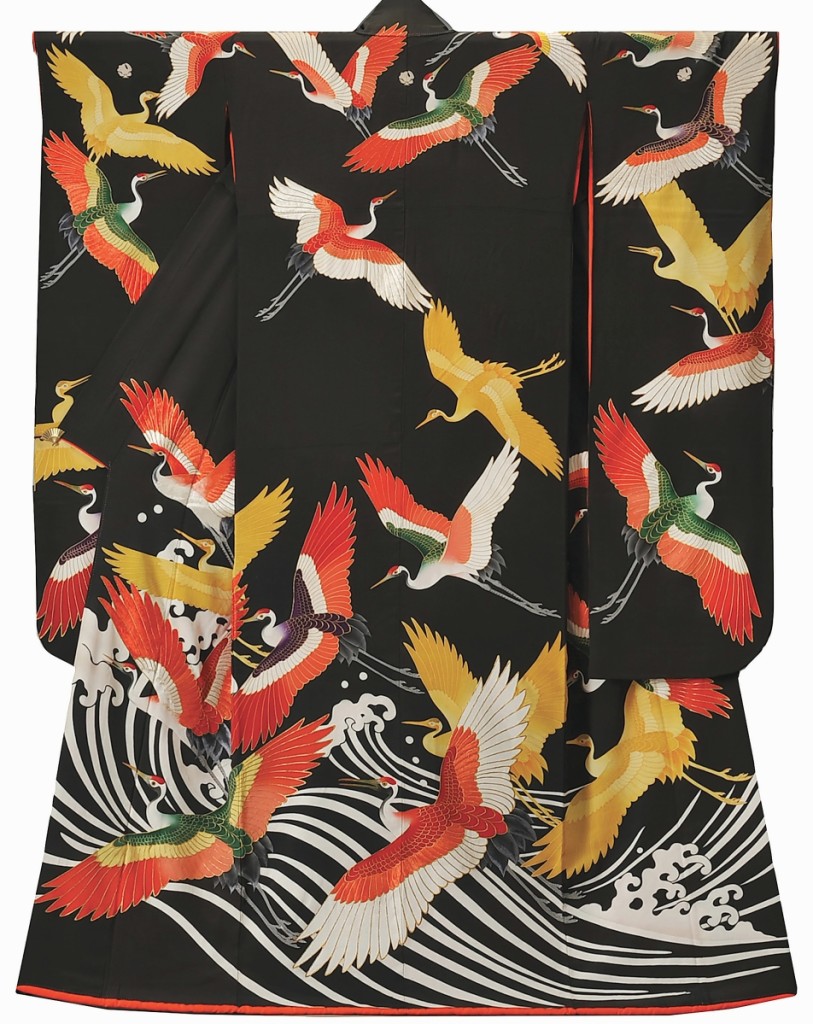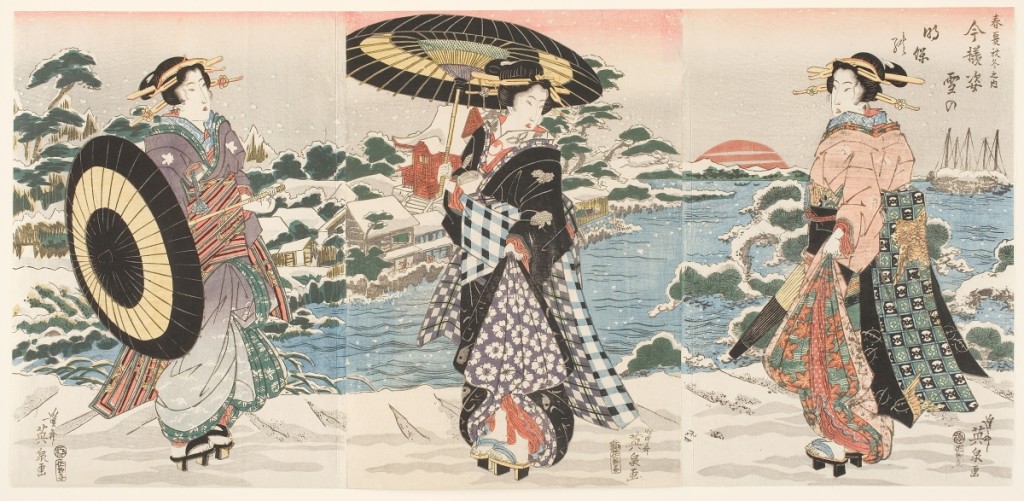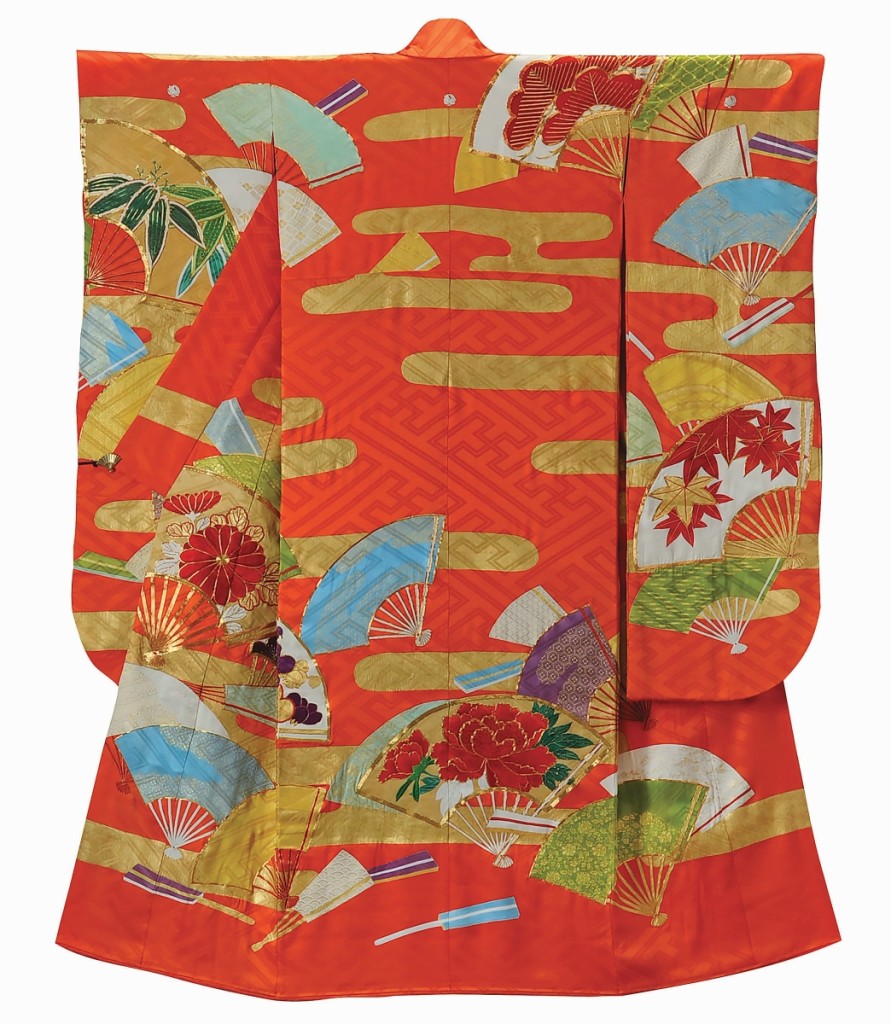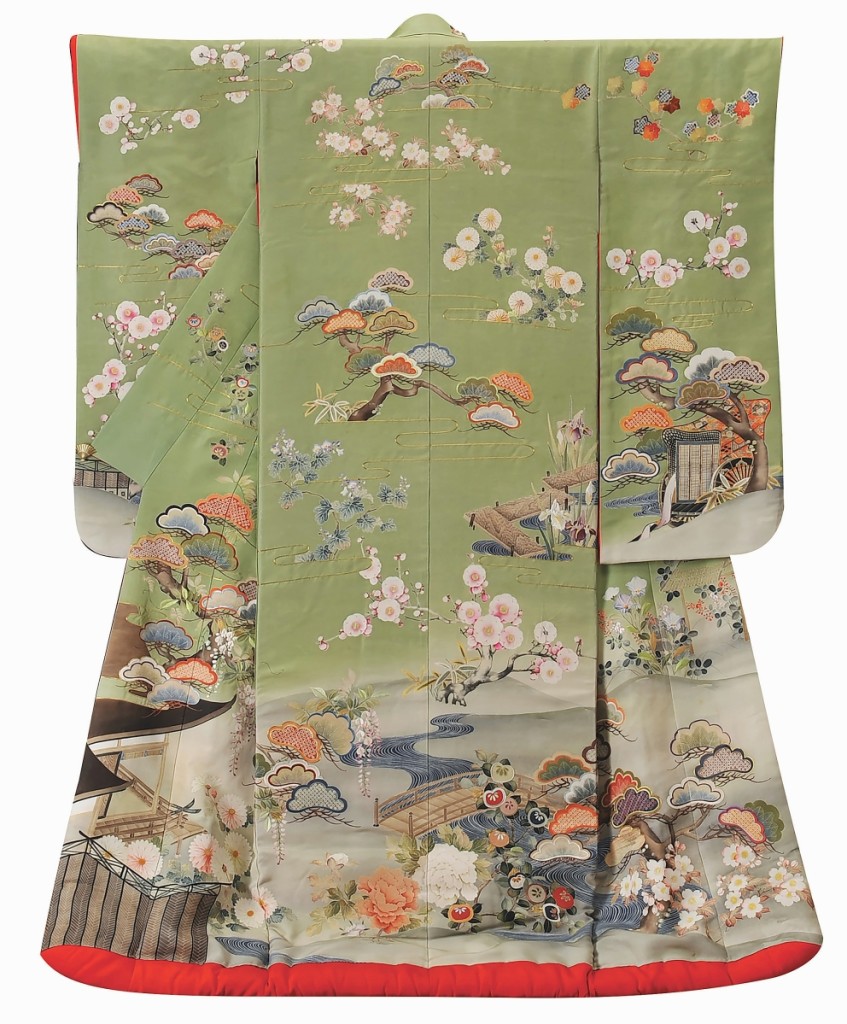
“Furisode with Wave and Crane Design, Made for Nishimura Tokuko, the fourteenth Madame Nishimura” by Chiso Co., Ltd, 1938. Yuzen-dyeing and embroidery on woven silk.
By Karla Klein Albertson
WORCESTER, MASS. – Finally, a pair of harmonious exhibitions you can slip your arms into and feel the rush of silk against the skin. Walking through “The Kimono in Print: 300 Years of Japanese Design” in the Worcester Art Museum (WAM) galleries through May 2, visitors can see colorful woodblock prints from the museum’s impressive collection, which features this distinctive garment. Judging by the illustrations, kimonos were worn by beautiful women on outdoor promenades, as stage costumes by fierce kabuki actors, and even at times flung on the floor to cushion amorous dalliance.
The exhibition was organized over several years by Vivian Li, who at the time was the associate curator of Asian art and global contemporary art at WAM; she also is the editor of the exhibition’s illustrated catalog, which fulfills her mission of sharing the museum’s collection with a wider audience. Li recently spoke with Antiques and The Arts Weekly: “The print show is based on material in the permanent collection with a few loans of kimono pattern books. When I got to WAM, of course, the first thing any curator does on the job is get to know the collection because exhibition projects revolve around it. We had a great collection of Japanese woodblock prints that hadn’t been highlighted in an exhibition. So that was something I was very excited about – to bring forward, to do more scholarship, to bring these prints to public attention.”
As she continued to do research on the print collection, figuring out what approach to take on the exhibition, the curator explained, “I talked to other scholars about the relationship between print culture and kimono fashion culture, a subject which had never been explored before. The majority of Japanese prints depicted actors and courtesans, and these were the fashion trendsetters of the Eighteenth and Nineteenth Centuries – what we would call ‘influencers’ today.”

“Modern Figures on a Snowy Day” by Keisai Eisen (1790-1848), early to mid-1820s, from the series “The Four Seasons,” published by Sanoya Kihei. Color woodblock print with graduated colors (bokashi) and blind-printing (karazuri). John Chandler Bancroft Collection.
Ordinary people would buy the affordable prints and follow the fashions popular in the “pleasure quarters” and theaters of the town as modeled by these actors and courtesans. One print by Tsukioka Yoshitoshi (1839-1892) is titled “Looking Delicious: Customs and Manners of a Prostitute of the Kaei Era,” 1888. Her dark hair pierced by ornaments, she wears a kimono of striped fabric while eating tempura shrimp; both that type of fabric and batter-fried food had been introduced by the Portuguese. Some trends have great longevity.
Styles for men were far from the boring dark suits of today. Master Utagawa Kunisada (1786-1865) produced an 1860 color woodblock print with graduated colors depicting “The Kabuki Actor Ichimura Uzaemon XIII” wearing a kimono patterned in odd squares against a triple-checked background so emphatic that it becomes almost op-art.
But wait – there’s more. The issue of kimono fashion, then and now, had arisen from the images on the prints and a chance meeting between Li and former colleague Christine Starkman. This gave birth to the idea of a side-by-side exhibition called “Kimono Couture: The Beauty of Chiso.” While the print show focused on kimonos as visualized by traditional artists, the couture counterpart presented the process of designing and creating kimonos from the viewpoint of the actual makers of the garments. Thanks to the disruptions of the past year, this latter show became a virtual exhibition in a series of installments. All are now up online to be enjoyed and rewatched by everyone – connect with the videos at https://www.worcesterart.org/exhibitions/kimono-couture/.

“Furisode with Mist and Fan Design, Made for Kawakami Masako, the fifteenth Madame Nishimura” by Chiso Co., Ltd, 1971. Embroidery and gold leaf on woven silk.
When the two curators reconnected in New York, Starkman had recently returned from Kyoto where she had by chance come across an amazing establishment, a shop of the utmost discretion run by Chiso, founded in 1555, one of the oldest kimono companies still active today. In those early years until the beginning of the Meiji Era in 1868, the firm was known principally as a maker of Buddhist vestments, before turning to the garment which would become the international icon of Japanese style. When the late Nineteenth Century fashion for Japonisme swept the West, Chiso was able to make textiles and kimonos adapted to please customers abroad as well.
Chiso has remained an exclusive firm, as Vivian Li explained, producing only around two dozen kimonos a year for custom orders, each an expensive and complex project. The virtual exhibition makes clear the many steps of an elaborate process. This is not a couture of changing hemlines and sleeves. Each creation is a unified vision that includes an artist’s master design and preparation of fabrics with dying, embroidery and gold-leaf application by artisans practicing age-old techniques. Even while watching the process, the results appear as if by magic.
Over the centuries, Chiso had amassed its own museum collection of historic kimonos, prints and pattern books. The original exhibition of “Kimono Couture,” which was supposed to open in April 2020, would have brought to the museum 13 historic kimonos from Chiso’s collection, dating from the Seventeenth to Twentieth Centuries. One fabulous example is a Seventeenth Century Edo period kosode, or small-sleeved robe with black and gold swirls decorated with tie-dying and ink, which can be seen in the catalog. The volume also has wonderful period photos of women wearing kimonos at the time of their creation, such as a 1938 photo of the 14th Madame Nishimura in a long-sleeved kimono with an overall fan pattern.

“Uchikake with Palace Garden Design, Made for Iida Taka, the thirteenth, Madame Nishimura,” by Chiso Co., Ltd, 1913. Yuzen-dyeing and embroidery on woven silk.
Best of all, the museum had commissioned the Worcester Wedding Kimono, and that completed garment has arrived and will be seen in the galleries alongside “The Kimono in Print” exhibition. Designer Imai Atsuhiro took his inspiration from the environment of the area where the museum is situated, most specifically from the many maple trees. The Kimono Couture catalog contains a lengthy interview with the artist and all nine of his original pattern drawings. There he notes, “People have always looked to nature for inspiration, and that is no different with kimono design… So here, I have rendered the maple leaf as an octagon, making it into a pattern. This is then placed such that it offers a sense of beauty throughout the design.”
“The Kimono in Print: 300 Years of Japanese Design” is accompanied by a catalog edited by curator Vivian Li, with contributions by Nagasaki Iwao, Ellis Tinios, Matsuba Ryoko, Fujita Kayoko and Stephanie Su. Published by Hotei Publishing, in association with the Worcester Art Museum, the catalog is available for purchase for $49.
“Kimono Couture: The Beauty of Chiso” was organized by the exhibition guest curators, Vivian Li and Christine Starkman, with contributions by Riyo Kikuchi and Yukio Lippit. Published by D Giles Limited, London, in association with the Worcester Art Museum, the catalog is priced at $34.95.
Catalogs can be ordered by contacting the museum shop, by emailing shopsales@worcesterart.org or calling 508-793-4355 to place an order and arrange for pick-up or delivery. Postage and handling costs will vary depending on weight and destination.

















